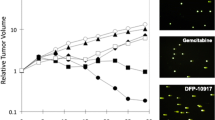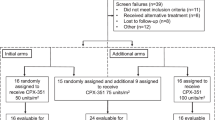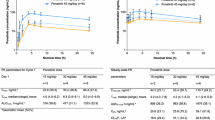Abstract
Cyclopentenyl cytosine (CPE-C) is an investigational drug that is active against human solid tumor xenografts. The 5′-triphosphate of CPE-C inhibits CTP synthase, and depletes CTP and dCTP pools. We conducted a phase I clinical trial of CPE-C given as a 24-h continuous i. v. infusion every 3 weeks in 26 adults with solid tumors. The starting dose rate, 1 mg/m2 per h, was selected on the basis of both preclinical studies and pharmacokinetic data from two patients obtained after a test dose of 24 mg/m2 CPE-C as an i. v. bolus. Dose escalation was guided by clinical toxicity. A total of 87 cycles were given, and ten patients received four or more cycles. The mean CPE-C steady-state plasma levels (Cpss) increased linearly from 0.4 μM to 3.1 μM at dose levels ranging from 1 to 5.9 mg/m2 per h (actual body weight); the mean total body clearance was 146±38 ml/min per m2. CPE-C was eliminated by both renal excretion of intact drug and deamination to cyclopentenyl uracil in an apparent 2∶1 ratio. CTP synthase activity in intact bone marrow mononuclear cells was inhibited by 58% to 100% at 22 h compared to matched pretreatment samples at all CPE-C dose levels. When all data were combined, flux through CTP synthase was decreased by 89.6%±3.1% at 22h (mean ± SE,n=16), and remained inhibited by 67.6%±7.7% (n=10) for at least 24 h post-CPE-C infusion. Granulocyte and platelet toxicities were dose-dependent, and dose-limiting myelosuppression occurred during the initial cycle in two of three patients treated with 5.9 mg/m2 per h. Four of 11 patients (4 of 20 cycles) who received 4.7 mg/m2 per h CPE-C experienced hypotension 24–48 h after completion of the CPE-C infusion during their first (n=2), third (n=1) and sixth cycles (n=1), respectively. Two of these patients died with refractory hypotension despite aggressive hydration and cardiopulmonary resuscitation. One of 12 patients (28 total cycles) treated with 3.5 mg/m2 per h CPE-C experienced orthostatic hypotension during cycle 1, and this patient had a second episode of orthostatic hypotension at a lower dose (3.0 mg/m2per h). Hypotension was not seen in patients receiving ≤2.5 mg/m2 per h CPE-C. The occurrence of hypotension did not directly correlate with either CPE-C Cpss, CPE-U plasma levels, pretreatment cytidine plasma levels, baseline CTP synthase activity, or with the degree of enzyme inhibition during treatment. While the hypotension appeared to be dose-related, its unpredictable occurrence and the uncertainty concerning the mechanism preclude a recommendation of a tolerable dose for future studies.
Similar content being viewed by others
References
Marquez VE, Lim M-I, Treanor SP, Plowman J, Priest MA, Markovac A, Khan MS, Kaskar B, Driscoll JS (1988) Cyclopentenylcytosine. A carbocyclic nucleoside with antitumor and antiviral properties. J Med Chem 31:1687
Lim M-I, Moyer JD, Cysyk RL, Marquez VE (1984) Cyclopentenyluridine and cyclopentenylcytidine analogues as inhibitors of uridine-cytidine kinase. J Med Chem 27:1536.
Kang GJ, Cooney DA, Moyer JD, Kelley JA, Kim H-Y, Marquez VE, Johns DG (1989) Cyclopentenylcytosine triphosphate. Formation and inhibition of CTP synthetase. J Biol Chem 264:713
Ford H Jr, Cooney DA, Ahluwalia GS, Hao Z, Rommel ME, Hicks L, Dobyns KA, Tomaszewski JE, Johns DG (1991) Cellular pharmacology of cyclopentenyl cytosine in Molt-4 lymphoblasts. Cancer Res 51:3733
Yee LK, Allegra CJ, Trepel JB, Grem JL (1992) Metabolism and RNA incorporation of cyclopentenyl cytosine in human colorectal cancer cells. Biochem Pharmacol 43:1587
Glazer RI, Knode MC, Lim M-I, Marquez VE (1985) Cyclopentenyl cytidine analogue. An inhibitor of cytidine triphosphate synthesis in human colon carcinoma cells. Biochem Pharmacol 34:2535
Moyer JD, Malinowski NM, Treanor SP, Marquez VE (1986) Antitumor activity biochemical effects of cyclopentenyl cytosine in mice. Cancer Res 46:3325
Glazer RI, Cohen MB, Hartman KD, Knode MC, Lim M-I, Marquez VE (1986) Induction of differentiation in the human promyelocytic leukemia cell line HL-60 by the cyclopentenyl analogue of cytidine. Biochem Pharmacol 35:1841
Dahut WL, Allegra CJ, Grem JL (1993) Modulation of cyclopentenyl cytosine toxicity by cytidine and dipyridamole in human colon cancer cells. Proc Am Assoc Cancer Res 34:284
Tomaszewski JE, Heath JE, Grieshaber CK, Page JG (1990) Toxicity of cyclopentenyl cytosine (NSC-375575) in CD2F1 mice and Fischer-344 rats. Proc Am Assoc Cancer Res 31:441
Page JG, Heath JE, Tomaszewski JE, Grieshaber CK (1990) Toxicity and pharmacokinetics of cyclopentenyl cytosine (NSC 375575) in beagle dogs. Proc Am Assoc Cancer Res 31:442
Zaharko DS, Kelley JA, Tomaszewski JE, Hegedus L, Hartman NR (1991) Cyclopentenyl cytosine: interspecies predictions based on rodent plasma and urine kinetics. Invest New Drugs 9:9
Blaney SM, Balis FM, Hegedus L, Heideman RL, McCully C, Murphy RF, Kelley JA, Poplack DG (1990) Pharmacokinetics and metabolism of cyclopentenyl cytosine (CPE-C) in nonhuman primates. Cancer Res 50:7915
Blaney S, Balis FM, Grem J, Cole DE, Adamson PC, Poplack DG (1992) Modulation of the cytotoxic effect of cyclopentenyl-cytosine by its primary metabolite, cyclopentenyl uridine. Cancer Res 52:3503
Russ PL, Hegedus L, Kelley JA, Barchi JJ, Marquez VE (1992) The controlled stereospecific reduction of cyclopentenyl cytosine to carbodine and isocarbodine. Nucleosides Nucleotides 11:353
Garibaldi M, Perrier D (1982) In: Swarbrik J (ed) Pharmacokinetics, 2nd edn, vol 15, Marcel Dekker. New York, pp
Fischer PH, Willson JKV, Risueno C, Tutsch K, Bruggink J, Ranhosky A, Trump DL (1988) Biochemical assessment of the effects of acivicin and dipyridamole given as a continuous 72-hour intravenous infusion. Cancer Res 48:5591
Moriconi WJ, Slavik M, Taylor S (1986) 3-deazauridine (NSC 126849), an interesting modulator of biochemical response. Invest New Drugs 4:67
Ahluwalia GS, Grem JL, Hao Z, Cooney DA (1990) Metabolism and action of amino acid analog anticancer agents. Pharmacol Ther 46:243.
O'Dwyer PJ, Alonso MT Leyland-Jones B (1984) Acivicin: a new glutamine antagnosit in clinical trials. J Clin Oncol 2: 1064
Lokich JJ, Chawla PL, Jaffe N, Frei E III (1975) Phase I evaluation of cyclocytidine (NSC-145668). Cancer Chemother Rep 59:389
Bender RA, Hamel E, Hande KR (1990) Plant alkaloids. In: Chabner BA, Collins JM (eds) Pharmacologic principles of cancer treatment, 2nd edn. W. B. Saunders, Philadelphia, p 180
Bibby MC, Double JA (1993) Flavone acetic acid-from laboratory to clinic and back. Anticancer Drugs 4:3
Grem JL, Cheson BD, King SA, Leyland-Jones B, Suffness M (1988) Cephalotaxine esters: antileukemic advance or therapeutic failure? J Natl Cancer Inst 80:1095
Cysyk RL, Malinowski N, Marquez V, Zaharevitz D, August EM, Moyer JD (1994) Cyclopentenyl uracil: an effective inhibitor of uridine salvage in vivo. Biochem Pharmacol 49:203
Ford H Jr, Driscoll JS, Hao Z, Dobyns KA, Rommel ME, Stowe E, Anderson JO, Waud WR, Plowman J, Johns DG, Cooney DA (1994) Reversal by cytidine of cyclopentenyl cytosine-induced toxicity in mice without compromise of antitumor activity. Biochem Pharmacol 49:173
Grem JL, Allegra CJ (1990) Enhancement of the toxicity and DNA incorporation of arabinosyl-5-azacytosine and cytosine arabinoside by cyclopentenyl cytosine. Cancer Res 50:7279
Author information
Authors and Affiliations
Rights and permissions
About this article
Cite this article
Politi, P.M., Xie, F., Dahut, W. et al. Phase I clinical trial of continuous infusion cyclopentenyl cytosine. Cancer Chemother. Pharmacol. 36, 513–523 (1995). https://doi.org/10.1007/BF00685802
Received:
Accepted:
Issue Date:
DOI: https://doi.org/10.1007/BF00685802




